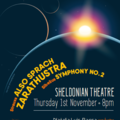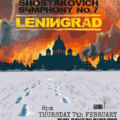2018-19
Thursday 1st November 2018, Sheldonian Theatre
Conducted by Natalia Luis-Bassa
Led by Ellen Dunn
Strauss Also Sprach Zarathustra
Sibelius Symphony No.2
A review of this concert can be found here:
Oxford University Orchestra Michaelmas Term Concert - Daily Info | Daily Info
Fitting the fragments into an organic whole
The Michaelmas concert from Oxford University Orchestra betokened a heartening snapshot of the state of student music in Oxford. Roughly 95% of the players are undergraduates, it looked not far off a sell-out, and taken with the almost 90 players, I would think it as numerous an orchestra as the Sheldonian has housed for many a long day.
The programme featured two works composed within seven years of each other. One of the two remarkable features of Strauss' Thus Sprach Zarathustra, a tone poem from 1896, is that it was composed just four years after Friedrich Nietzsche's eponymous work, a sort of rhapsody on the mysteries of life. Quotes from Nietzsche adorn the first page of the score, suggesting a programmatic intention for the beginning and last pages at least. Zarathustra, ie Zoroaster, the prophet of Persian myth, weary of his wisdom, chooses to return to dwell with mankind and by inference to lead it forward. The second remarkable feature is that the opening fanfare was used by Elvis Presley as the music to which he took the stage for his gigs in the last half dozen years of his life, and it was played at his memorial service.
The work commences with growling double-bass before Sonnenaufgang [sunrise] is conjured up from the celebrated trumpet call, here a suitably big sound from our four players, to the galactic climax, of course familiar to all sci-fi and Kubrick fans as the call to arms in 2001: A Space Odyssey. There followed an ecstatic passage for strings and organ, although the former showed faltering frailty here. The various sub-sections of the orchestra were served first by an episode for flutes and trilling clarinets representing a dance of Cupid, then by a wild plunge of trumpets portraying the descent to Earth of Zarathustra.
Strauss' aural imagination is astonishing, though the mood musics in the second half are perhaps overlong – heroism, waltzing and impishness hurry past, for instance. There was an extended passage for glockenspiel which Max Rodney, clearly a talented percussionist, took at speed and very accurately – I was sitting just above his position - and then came the harmony cadences from the upper strings, their tone rather shrill at the end.
Percussionist Oliver Nelson's programme notes – the most informative of any I've seen for a student concert - talked of the fragmentary nature of Sibelius' 2nd Symphony material and the composer's skill in piecing the fragments together into an organic whole. How right he is, and he's captured the essence of the hesitations and pauses and sudden thrusts en route to the completion of the structure that devoted Sibelians like me cherish in each of the seven symphonic masterpieces.
Conductor Natalia Luis-Basso took the repeated-note pulsations at the start at a decent tempo – she brought the symphony in at the 43 minutes mark; about standard time – and then a dance from the woodwinds announced their capabilities. The trumpets and trombones, often all together, produced a noble sound in the fanfares. I was especially taken by the oboes of Emily Crichton (excellent solo from her in the third movement) and Tetsu Isaji, and also the bassoons of Ho Ting Chan and Bruce Parris, both prominent in conjunction with the cellos and basses in the remarkable pizzicato passage at the start of the Andante. The horns, on the other hand, I thought a little erratic; muffled in their opening contribution and then over-emphatic at the end of the Allegretto. Luis-Basso used many sinuous, almost feline gestures, avoiding any suggestion of flamboyance. The violins kept a sharp eye on her, and I thought their sound grew in confidence all evening long.
It's significant that although by the late 1930s Sibelius had ceased to compose, he continued to follow the progress of Shostakovich. The latter must have been influenced in the passages of driving rhythms that propel his 15 symphonies. And where would Shostakovich have sought for his inspiration but in the processional music that concludes this symphony, basically a five-finger exercise that repeats for almost 80 bars, a great engine that propelled the final tune inexorably on its way. The timpani crashed out, the pressure increased, the effect was overwhelming.
Thursday 7th February 2019, Sheldonian Theatre
Conducted by Peter Stark
Led by Ellen Dunn
Shostakovich Symphony No.7 "Leningrad"
Reviews of this concert can be found here:
Review: OUO, Shostakovich 7 – HT19 (oums.co.uk)
Oxford University Orchestra Hilary Term Concert - Daily Info | Daily Info
Evoking a tsunami of emotion
A packed Sheldonian Theatre was livelier than usual, as hoards of students streamed in to support the Oxford University Orchestra (OUO), and from the delight on the faces of the musicians, many of their friends.
The ensemble encourages many of the University’s top musicians to come together to play challenging and exciting repertoire with exceptional professional conductors and soloists.
In a thrilling performance of Shostakovich’s Symphony No 7 (Leningrad), OUO’s talented student musicians were conducted by Peter Stark, Professor of Conducting at the Royal College of Music. Together, their alchemy released deep emotion in the audience, and rapturous applause.
One of Shostakovich’s most famous and widely performed works, the Leningrad Symphony was written under the duress of war, during the starvation and bombardment of St Petersburg by Nazi troops in 1941, in a siege which lasted for almost 900 days, and resulted in the deaths of a million civilians.
‘I was guided by a great love for the man in the street,’ Shostakovich wrote. ‘Love for the people who have become the bulwark of culture, civilisation and life. I love them from the bottom of my heart.’ On hearing the ‘invasion theme’ of the monumental first movement when it was first performed under Stalin’s authoritarian regime - authorised as a direct response to German aggression - many Russian listeners wept.
The composer’s vision was much larger than anti-fascism: ‘other enemies of humanity’ may well have included Stalin himself. Under the Great Purges, open displays of grief and loss were impossible. Such is the power of the music, adapted and composed afresh at breakneck speed in response to the deepening suffering around him, I – and many of the Sheldonian audience - were similarly deeply moved.
The four movements reflecting the onset of war, a lyrical intermezzo, an adagio with inset drama and victory as a finale were a technical, emotional and dramatic challenge that the young musicians carried with precision and passion.
It was only when Peter Stark mentioned the ‘B’ word that we were reminded of our current concerns – but it was to highlight the OUO Japan Project in March 2019 when 30 OUO musicians and guest conductor Cayenna Ponchione-Bailey will share and perform with students in Fukushima as part of the regeneration project on the eighth anniversary of the nuclear disaster there. Donations in ‘B’ for buckets on the night – but more always welcome...
As the orchestra rose for a final time, after waves of repeated applause, Leader Ellen Dunn plucked a flower from her bouquet and presented it to a fellow violinist. In that small gesture, wider co-operation was evidenced.
The Oxford University Orchestra delivered a stupendous performance of Shostakovich’s seventh symphony on the evening of the 7th of February 2019 under the direction of Peter Stark, in the magnificent setting of the Sheldonian theatre. The excited chatter and restlessness of a predominantly student-filled audience subsided as soon as the stately opening bars were played, and thus began an hour and a half of captivating music. The complete programme was dedicated to this powerful piece, the orchestra even refraining from playing encores, which seemed fitting out of respect for this momentous and historically significant work, which is still regarded as a tribute to the sacrifice of millions of Soviet citizens during the Second World War, as well as allowing a completely immersive listening experience. This is a notoriously long and demanding piece, requiring great stamina and concentration both from the musicians and the audience – to have been able to keep the audience engrossed for the entirety of the performance is a mark of great musicianship.
The orchestra’s versatility was demonstrated in the first movement, which boasts various themes (including the famous “invasion theme”), textures, and moods. Perhaps even more impressive than the magisterial, imposing sections were the more lyrical ones: the Sheldonian is a large and imposing building yet the orchestra was able to create beautiful moments of intimacy in the more reflective passages. The series of ethereal solos towards the beginning of this movement were played with remarkable sensitivity and subtlety, and even more remarkable, one felt the soloists were really listening to each other. This level of co-operation between the musicians themselves was maintained throughout the performance, and, in addition to Peter Stark’s great direction, helps to explain how they were able to consistently achieve a perfect balance of sound.
The allegretto was taken at a brisker pace than some recordings, but this suited the orchestra’s energetic dynamic. There is nothing stoic about the OUO’s playing, and it was wonderful to see the players commit even physically to the lilting rhythm of the movement. Above the playfulness of the strings, the solo oboist delivered a particularly fine and entrancing performance.
After the still opening of the third movement, originally entitled “Home Expanses”, the music became increasingly frenzied, and this was when the orchestra really shone. Strangely, an orchestra which plays with such exuberance was suited to playing the colossal and ambiguous ending of this momentous symphony. As the end of the fourth movement grew into a ferocious climax in C major, I actually heard multiple gasps around me, as the effect of the whole orchestra playing at full volume, as well as a section of brass playing in the upper stalls, was truly overwhelming. However, this is supposed to be deeply troubling music. The finale was indeed cathartic, and perhaps the tone might have been different had the audience allowed a moment of silence and reflection after the final chord instead of immediately bursting into wild applause (though I am in no way condemning this enthusiasm). The OUO’s playing was dramatic, fine, even beautiful, but it did not convey that lurking sense of evil which this piece is capable of conveying, and which indeed makes it so haunting. This all comes down to the tricky question of interpretation, yet that element of unpleasantness which I felt was slightly lacking is essential to this piece’s “message”, if it is to have a message at all.
The lasting impression I had of this performance was one of triumph, not fear or pain. In the wider context of the world’s present bleak political situation, this triumphant interpretation was admirable and much appreciated, as was evident from the audience’s enthusiastic clapping, almost cheering, at the end of the piece (and indeed, between the movements themselves, which Peter Stark graciously accepted). It is also incredibly refreshing, and surprisingly rare, to witness an ensemble’s pure enjoyment of sound, enjoying music for music’s sake. I, like so many others, exited the grandeur of the Sheldonian into the February night air thrilled.
Saturday 25th May 2019, Sheldonian Theatre
Conducted by Cayenna Ponchione-Bailey
Featuring Carson Becke (Piano)
Led by Violetta Suvini
Brahms Symphony No.4
Clara Schumann Piano Concerto
Robert Schumann Manfred Overture
Clara Schumann (neé Wieck) (1819-1896) was a musical force of nature and a child prodigy. At the age of 13 (1832) she began composing her first piano concerto, which, rather than being derivative like many pieces of juvenilia, is a unique and bold artistic statement. The three-movement concerto took its final form by 1834 and was premiered at the Leipzig Gewandhaus in 1835 with herself at the piano and Felix Mendelssohn conducting. Despite the excellent quality of the work and her international reputation as a performer, like many works written by female composers in the 19th century, it has seldom been performed after her death. In her bicentennial year, the Oxford University Orchestra undertook a rare performance of this concerto under the direction of conductor Cayenna Ponchione-Bailey with pianist Carson Becke. As part of the rehearsal process, Clara Schumann scholars, Dr Joe Davies and Professor Susan Wollenberg, led a public performers’ workshop, bringing to life the musical world in which Clara Wieck created this wonderful work and giving a tour of the concerto’s compositional structure with live examples performed by Carson Becke and OUO.







